波兰/法国/德国/比利时/乌克兰/俄罗斯/荷兰/瑞士/英国/奥地利
波兰
1. LuPO4:Eu3+
[Fine structure in high resolution 4f7–4f65d excitation and emission spectra of X-ray induced Eu2+ centers in LuPO4: Eu sintered ceramics-JL-2019]
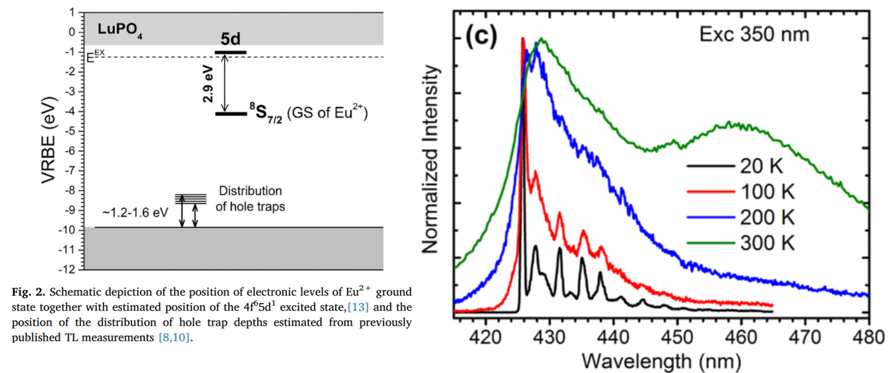 基于Dorenbos的理论,Eu2+的GS距离导带3.3 eV,所以Eu3+可以作为deep electron trap,而Eu2+的ES距离导带~0.4 eV,但是Dorenbos理论本身的误差就有~0.5 eV,所以极端情况Eu2+的ES可能在导带底之上,在这种情况下Eu2+是不发光的。所以作者想通过PL看看到底有没有Eu2+的PL,以此来确定Eu2+的最低激发态是不是在。
基于Dorenbos的理论,Eu2+的GS距离导带3.3 eV,所以Eu3+可以作为deep electron trap,而Eu2+的ES距离导带~0.4 eV,但是Dorenbos理论本身的误差就有~0.5 eV,所以极端情况Eu2+的ES可能在导带底之上,在这种情况下Eu2+是不发光的。所以作者想通过PL看看到底有没有Eu2+的PL,以此来确定Eu2+的最低激发态是不是在。- 对于辐照后的样品,在室温下测PL观察到上图的两个发光峰,短波长的发光峰来源于真实的Eu2+的发光。对于长波长的峰,We do not exclude that it is the so-called anomalous Eu2+ luminescence resulting from an impurity (Eu)-trapped exciton state. This hypothesis is supported by the fact that the 4f65d1 excited level is positioned very close to conduction band. At elevated temperatures, this state may be thermally populated and give rise to trapped exciton emission.
- TL测试:升温得到的是Eu3+的发光,which indicates that the trapped charge carriers - electrons and holes - recombine during the TL process at the Eu dopant. 注意是releases trapped holes and recombination at Eu-sites。
- Ionizing radiation产生的CB的电子被处在Lu3+格位的Eu3+捕获而还原,产生的VB空穴被\( \mathrm{O}_{\mathrm{O}}^{\mathrm{X}}\)捕获得到\(\mathrm{O}_{\mathrm{O}}^{\bullet}\)。Eu3+就是作为deep electron trap,其缺陷深度对应于Eu2+的基态到CB的距离(大约3.3 eV)。
- Thermal bleaching:All the absorption bands induced by X-rays disappeared after a short heating of the pellets to about 300 °C, as in TL experiments, and the white color of the sample was then restored.
2. LuPO4: Eu3+ YPO4: Eu3+
[Electron and hole trapping in Eu- or Eu,Hf-doped LuPO4 and YPO4 tracked by EPR and TSL spectroscopy-JMCC-2019]
The results relative to EPR and TL spectroscopy proved that in orthophosphates Eu3+ is an effective electron trapping center while holes may be trapped at impurity ions, like Pb2+, or localized at oxygen ions possibly stabilized by nearby defects, e.g. Lu-vacancies.
样品:
(1) YPO4:Eu,Hf单晶
(2) LuPO4:Eu 单晶
(3) LuPO4:Eu,Hf 单晶
(4) LuPO4:Eu 陶瓷
注:含Hf的原料中有Zr杂质,杂质可能同坩埚转移;单晶含有Pb杂质。
结论
- 所有的晶体都有Pb的ESR信号,因为Pb2P2O7 flux的缘故。
- 所有的样品在X射线的辐照下都观察到了Eu2+的EPR信号,Eu3+作为electron trap。
- LuPO4:Eu 陶瓷的hole trap是oxygen near Lu-vacancy,66 K之上the hole was found to undergo fast motion/hopping between a few oxygen atoms around the vacancy and only upon further cooling it got immobilized at one of them.
- Pb/Hf/Zr的四价离子也可以作为electron traps,辐照后被还原成有ESR信号的三价离子,也就是说b/Hf/Zr的四价离子和Eu3+是竞争关系,都可以捕获电子。
- 对单晶来说,hole trap是O− and PO42− molecular complex;而陶瓷的hole trap只有O−。
- 陶瓷中的O− center is deeper in ceramics due to stabilization with a neighboring Lu-vacancy。
实验结果-EPR
(1) YPO4:Eu,Hf单晶
辐照之后Eu2+的信号出现,和Pb3+的信号明显增强。
(2) LuPO4:Eu 单晶
辐照之后Eu2+和Zr3+的信号都出现,Gd3+和Pb3+信号减弱。
说明Eu/Zr可以作为electron trap;Gd/Pb可以作为hole traps。
(3) LuPO4:Eu,Hf 单晶
辐照之后Eu2+/Zr3+/Hf3+的信号都出现了,另外还出现了PO42-molecular complex(radical)的信号,另外还出现了低温下才能观察到的O-(hole-type,不是很确定)
(4) LuPO4:Eu 陶瓷
辐照之后Eu2+出现了,另外也出现了一个hole type center的信号,可能对应于O-。Q-band EPR测试可以观察到更精细的结构,通过变温测试,作者认为a hole is trapped at the oxygen ion under X-ray irradiation as the most probable modle for the trapped hole center. 高的热稳定性表明hole at the lattice oxygen must be stabilized by a defect nearby. This could be a vacancy at the Lu3+ site as the perturbation must be quite strong.
变温测试的结果说明O-表现出motionally narrowed origin。This motion could be due to thermal hopping of holes between the few oxygen ions in the nearest vicinity of Lu3+ vacancy. 注意这里的O-表和LuPO4:Eu,Hf 单晶的不同,因为后者没有表现出motionally narrowed origin。这种差异来自合成工艺的不同。
实验结果-thermal stability
(1) Gd3+ and Pb3+ impurity很稳定,EPR信号在加热到600度后依然不会消失,这些杂质离子在as-grown的样品里就存在了。
(2) 辐照后产生的O-、PO42-、Zr3+、Hf3+、Eu2+信号是thermally unstable defects。
乌克兰
1. LnVO4:Eu3+ (Ln = Gd, Y, La)
[Photobleaching of LnVO4:Eu3+ nanoparticles under UV-light irradiation: Effect of nanoparticle size-JL-2022]
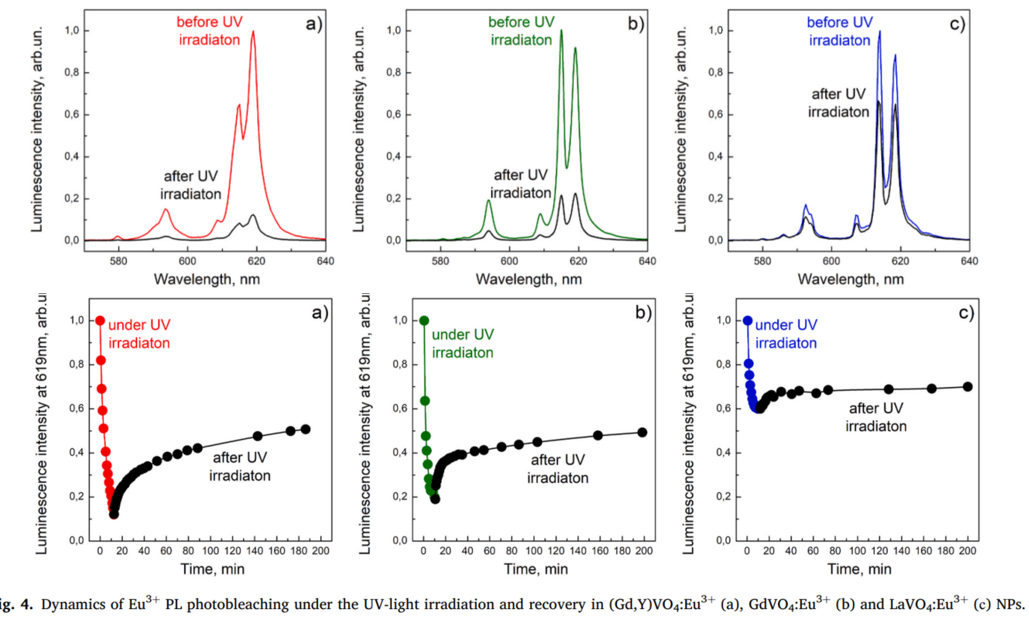
- GdVO4 and YVO4能给Eu3+提供高效发光的环境,因为存在钒酸根离子到Eu3+的非辐射能量传递。
- Gd3+的磁性,使得GdVO4: Eu3+ NPs bio-imaging markers for multimodal PET/MR。
- YVO4: Eu3+ NPs存在photobleaching的现象(UV-VIS辐照),对于其中的原因有两种观点:(它们之间)
-
- 观点-1:reduction of V5+ to V4+ that inhibits energy migration to Eu3+ ions,而制备过程中的citrate ions就是V5+的还原剂。
- 观点-2:reduction of Eu3+ to Eu2+ in YVO4:Eu3+ NPs under 466 nm laser irradiation。
-
- 作者的结论(作者这里用的是mercury lamp):The effciency of the photobleaching depends strongly on NPs size. (更小的尺寸,那么formation of chargecompensating oxygen vacancies VO for stabilization of reduced Eu2+ ions will require less energy) Presented here experimental data show that the photobleaching effect is associated with a photo-reduction of Eu3+ ions to Eu2+ via the electron transfer reaction under UV-light irradiation. 作者这里的掺杂浓度不高,另外Eu2+的发光和基质的发光存在重叠,导致无法清晰指认Eu2+的发光,但是可以看到UV辐照前后存在峰形的强度的些许变化。
- The reduction of Eu3+ to Eu2+ is a reversible process as can be seen. This effect could be explained by the Eu2+ oxidation to Eu3+ by oxygen presented in water solutions.
德国
1. Ba2SiO4:Eu3+和(Ba0.5Sr0.5)2SiO4:Eu3+
[The effect of X-ray exposure on Ba2SiO4:Eu3+]
[On the Luminescence of (Ba0.5Sr0.5)2SiO4:Eu3+ upon X-ray Exposure-托马斯-会议论文]
Eu3+ activated ortho-silicate is converted into Eu2+ doped ortho-silicate upon excitation by high energy radiation (> 5.0 eV)
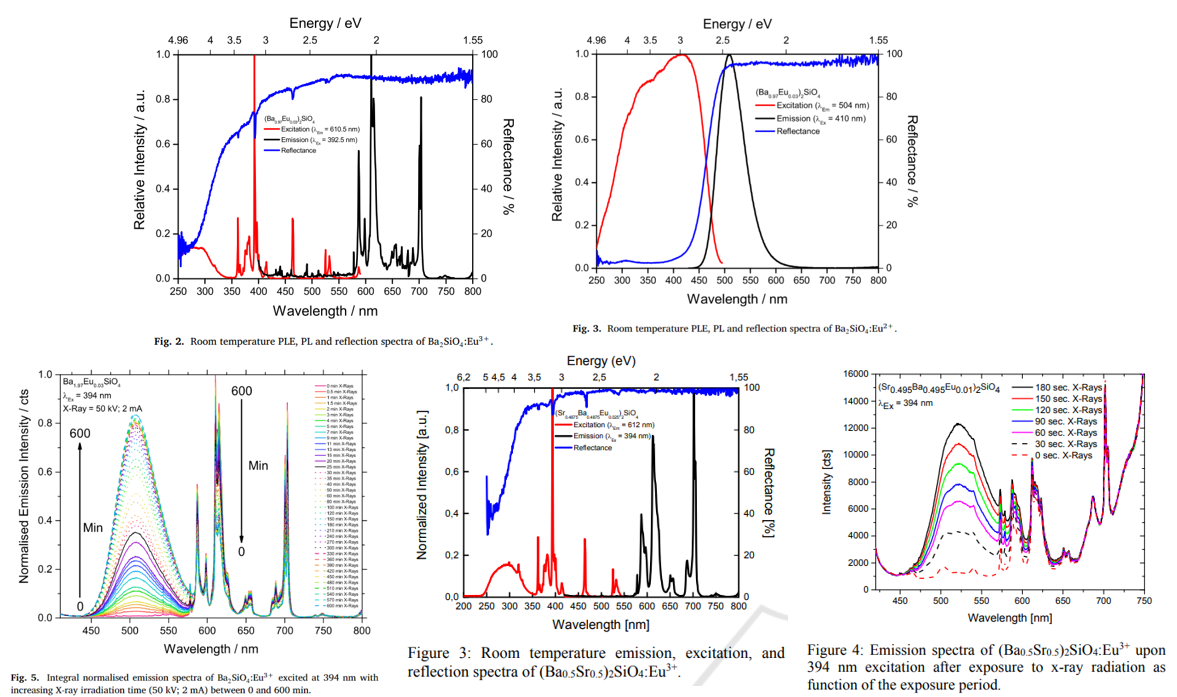
2. [Photoinduced redox reactions in Zr, Nb, Ta, Mo, and W doped glasses]
xxx
法国
1. silica-coated Y0.6Eu0.4VO4 nanoparticles
[Single europium-doped nanoparticles measure temporal pattern of reactive oxygen species production inside cells-Nature-Nanotech-2009]
辐照(466 nm激光)导致Eu3+被还原,而且观察到了Eu2+的发光。这里we directly excited the Eu3+ ions at 466 nm rather than the vanadate matrix in the UV, which may be harmful for cells.
 注意和乌克兰的文章对比。
注意和乌克兰的文章对比。
2. BaMgAl10O17: Eu2+
[Oxidation and Luminescence Quenching of Europium in BaMgAl10O17 Blue Phosphors-CM-2017]
3. Borosilicate玻璃: Sm
[Oxidation of Sm2+ in β-irradiated Sm-doped borosilicate glasses under laser illumination-JL-2005] 重点阅读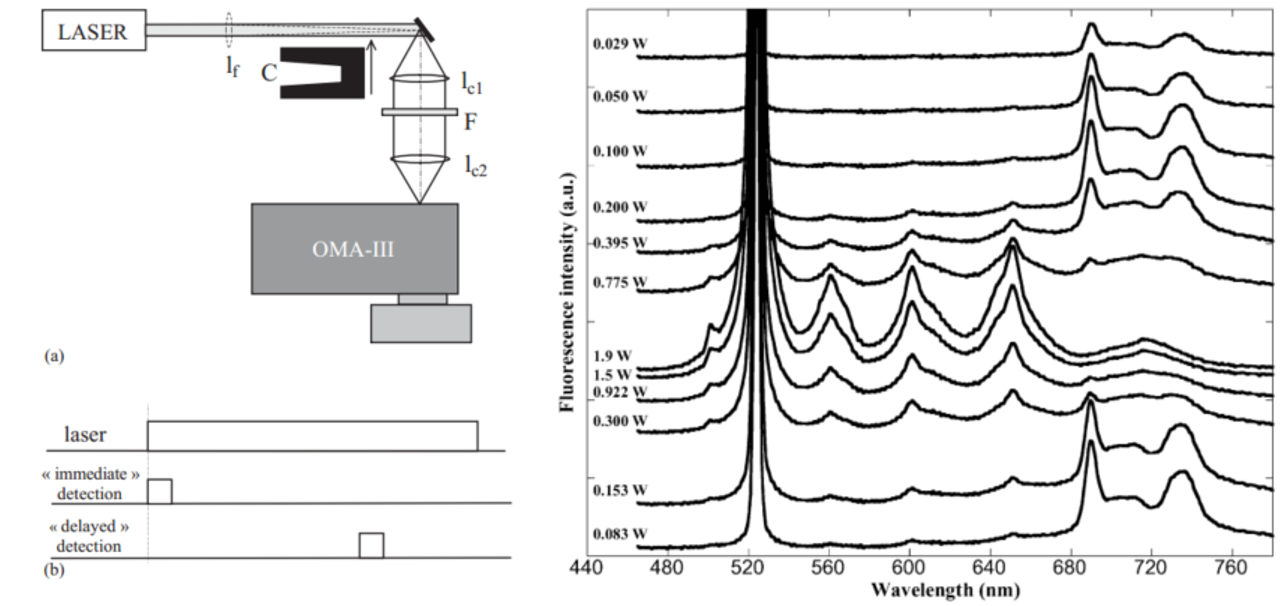
Introduction:
(1) Eu, Sm-doped BaF2 it was shown that a divalent impurity is photoionized and ejects an electron into the conduction band under irradiation by either 4.9 eV light for Eu2+ or 3.9 eV light for Sm2+ resulting in following photoreaction: $$\mathrm{Eu}^{2+}+\mathrm{Sm}^{3+}\stackrel{\mathrm{hv}}{\rightleftharpoons} \mathrm{Eu}^{3+}+\mathrm{Sm}^{2+}$$Consequently, a trivalent impurity can act as a trap and capture the free conduction-band electron, thus forming the corresponding divalent impurity.
(2) Sm doped SrFCl1/2Br1/2 crystal, a reversible process (persistent hole burning) $$\mathrm{Sm}^{2+}(\mathrm{A})+\mathrm{Sm}^{3+}(\mathrm{B}, \text { trap }) \underset{\mathrm{hv}}{\rightleftharpoons} \mathrm{Sm}^{2+}(\mathrm{A}, \text { trap })+\mathrm{Sm}^{2+}(\mathrm{B})$$和之前[Photon-gated hole burning: a new mechanism using two-step photoionization-OL-1985]报道的类似。
(3) a photoinduced electron transfer for Sm ions by photoionization followed by an electron trapping at a site other than Sm3+(Room-temperature persistent hole burning of Sm2+ in oxide glasses-OL-1993) $$\mathrm{Sm}^{2+}+(\operatorname{trap}) \stackrel{\mathrm{hv}}{\longrightarrow} \mathrm{Sm}^{3+}+(\operatorname{trap})^{-}$$和之前[Photon-gated hole burning: a new mechanism using two-step photoionization-OL-1985]报道的类似。
(4) In this paper we report the preparation of Sm3+-doped 5-oxide glasses and production of Sm2+-doped ones by exposing to strong β-irradiation (4×109 Gy), investigation of their fluorescence and explanation of Sm2+ transformation mechanism.
实验现象:
(1) β-irradiated (4x109 Gy)后的样品,在532 nm (Nd:YAG)的激发下可以观察到689 nm和703 nm的发光,来自Sm2+。后面的测试都是基于β-irradiated的样品。
(2) unfocused geometry下测试PL (532 nm激发):低激光强度的激发下,只观察到Sm2+的发光,
(3) delayed spectrum的Sm2+发光强度会降低,激光强度越大,delayed spectrum的Sm2+发光强度降低越明显(注:其实就是因为photo-oxidation)。
(4) 如果将激光聚焦,即focused geometry下,激光强度足够大的时候(1.9 W),只能观察到Sm3+,Sm2+的发光完全消失。This confirms therefore that the oxidation of Sm2+ to the Sm3+ ions occurs completely in case of high laser intensity.
讨论:It is obvious that illumination by intensive light produces both optical and thermal effects. 作者认为后者才是原因。如果采用short laser pulses去 suppresses thermal effect,比如 400 nm的 40 fs,发现no sign of reduction of Sm2+ due to laser irradiation can be detected. (注:这里读起来有点混乱)
结论:We conclude that the increased sample temperature during laser irradiation explains these phenomena. During laser excitation the glass sample temperature is increased resulting in liberation of the electron from Sm2+, forming an Sm3+ ion. Another crucial aspect is the reversibility of this process. After stopping laser irradiation, Sm2+ and Sm3+ ions return to their initial proportion into the glass. In this context it is interesting to note that thermal stimulation of charge transfer in crystals were reported in the literature in codoped samples.
我的思考:作者这里的实验和我的有点不同,因为我的功率没有那么高,但是作者在低功率下也观察到了Sm2+的氧化,而且作者也没有给出Sm2+的激发谱,我认为还是发生了光致氧化,而不是热的作用。作者后面也做了125 K下Nd激光辐照的实验,没有观察到Sm2+的氧化,文中作者说the conversion observed at room temperature is not of optical origin, which implies that it is due to the thermoionization process under optical excitation of the sample,但是我认为是可能需要一点点热辅助来实现photo-oxidation。
4. Sm-doped aluminoborosilicate glasses
[Optical properties of pristine and γ-irradiated Sm doped borosilicate glasses-2005]
- clustering effect:
(1) 浓度猝灭:掺杂浓度为 1 wt%的时候就开始出现浓度猝灭,可能和a clustering effect due to an inhomogeneous distribution of Sm inside the glass有关。
(2) hopping - Sm2+的含量随着辐照剂量的增加而增加,explained by the increase of electron trapping processes as a function of dose due to exciton (electron–hole pairs) production during irradiation.
- Clustering effect:Since the positive charge of Sm3+ ions is not fully compensated by the non-bridging oxygens, clustering of Sm3+ ions takes place which result in more complicated local environment around Sm3+.
5. Sm-doped aluminoborosilicate glasses完全还原
[Optical properties and valence state of Sm ions in aluminoborosilicate glass under β-irradiation-JNCS-2007]
结论:The optical properties of β-irradiated Sm-doped aluminoborosilicate glasses were investigated by luminescence, EPR and Raman spectroscopies. We found that Sm3+ ions can be completely reduced into Sm2+ by β-irradiation with doses higher than 109 Gy. The EPR measurements have shown that the hole defect production strongly depends on the dopant amount and has tendency to diminish with the increase of Sm content. With the addition of Sm2O3, a decrease of the structural changes under irradiation (decrease of average Si–O–Si angle, increase of glass polymerisation) has been observed by Raman spectroscopy. Absence of correlation between the quantity of trapped electrons and holes produced during irradiation let us suggest that hole defects are not the counterpart of Sm3+ ions reduction processes and another mechanism, like gas production, must be taken into account in order to explain the results obtained by luminescence.
6. Eu2O3-doped aluminoborosilicate glasses
[Reduction of Eu3+ to Eu2+ in aluminoborosilicate glasses under ionizing radiation-MRB-2010]
摘要:Eu2O3-doped aluminoborosilicate glasses were prepared by melting in air at high temperature (∼1500 °C). It was shown by luminescence and Electron Paramagnetic Resonance (EPR) measurements that both Eu3+ and Eu2+ ions can exist simultaneously in the glass matrix studied after glass synthesis as well as after exposure to ionizing radiation. Increase of total Eu2O3 concentration leads to the increase of Eu3+ luminescence intensity while the luminescence intensity of Eu2+ ions tends to decrease. In contrast the EPR indicates that the amount of Eu2+ ions in the glass increases with total Eu2O3 concentration. The difference in the results of the two spectroscopies is explained in terms of energy transfer from Eu2+ to Eu3+ leading to an Eu2+ luminescence quenching. Irradiation results in the increase of reduced Eu2+ quantity detected by EPR measurements. It was shown that Eu2+ ions are located in both high (g ∼ 4.6) and low symmetry (“U’ spectrum) sites in the structure of aluminoborosilicate glasses. The increase of Eu2+ content by the increase of the irradiation dose manifests the strong reduction process Eu3+ → Eu2+.
要点:Taking into account, that Eu3+ ion is an active electron trap, it is apparent to consider that ionizing radiation such as γ-rays or irradiation with femtosecond laser pulses, results in the formation of Eu2+ ions after Eu3+ reduction.
7. ScVO4:Bi3+
[Luminescence depreciation in ScVO4:Bi3+ upon irradiation in the Bi3+-related absorption bands-JL-2022]
比利时
1. CaAl2O4:Eu
[Valence states of europium in CaAl2O4:Eu phosphors-OME-2012]

- 合成方法/溶胶凝胶的优势:Different kinds of techniques have been used to prepare Eu2+ doped CaAl2O4 such as solid state reaction, co-precipitation, microwave, Pechini, combustion and sol-gel synthesis Comparing these methods, sol-gel synthesis possesses some benefits, namely, relatively low preparation temperature, easy control of the stoichiometry, high levels of product homogeneity, and no need for the use of expensive equipment. In most of the techniques a heat treatment under a reducing atmosphere is necessary to obtain Eu2+.
- 两种方法to assess the valence state of Eu:
-
-
- PL and PLE — straightforward to assess the presence of Eu2+ and Eu3+,但是it is far from obvious to determine the fraction of both species from PL spectroscopy.
- XAS — a powerful tool to investigate the valence states of Eu。
-
-
- PL测试:分别用260 nm和330 nm去激发Eu3+和Eu2+。It is not straightforward to determine the ratio between the number of Eu2+ and Eu3+ luminescence centers for the emission spectra, as the relative excitation efficiency of both ions depends on the wavelength of the excitation light. 二者的不同波长下的吸收截面不同,另外energy transfer between ions might occur and finally non-luminescent centers can also be present.
- 样品变gray:the body color of the powders, which is white before post-annealing, turns to gray by post-annealing under H2/N2 and gets darker by increasing the temperature. A powder with a gray body color is not desirable for luminescence applications due to the strong (internal) absorption of the luminescent emission. The gray body color is presumably related to oxygen vacancies.
- At 900°C, the emission spectrum is dominated by Eu2+, even for an excitation wavelength which preferentially excites Eu3+, although XANES indicates that less than half of the europium ions are reduced to Eu2+. For the highest annealing temperatures used, the emission spectrum hardly contains Eu3+-related emission, while according to the XANES results there is still a significant fraction of Eu3+ ions.
- Hölsä实验现象:observed only the presence of Eu2+ in CaAl2O4:Eu and small fractions of Eu3+ if co-dopants were used. (固相法+还原气氛)
- 总结:A considerable fraction of Eu3+ ions can be present in the powders, although this is not necessarily reflected in the photoluminescence properties.
- 共掺杂Nd得到的长余辉性能并不好,可能是因为样品变灰色了,which leads not only to a strong absorption of the excitation light by defects (instead of by the europium ions) but also hampers the emitted light to leave the sample.
2. CaAl2O4:Eu,Nd sol-gel + electron beam annealing
[Extending the afterglow in CaAl2O4:Eu,Nd persistent phosphors by electron beam annealing-OME-2012]
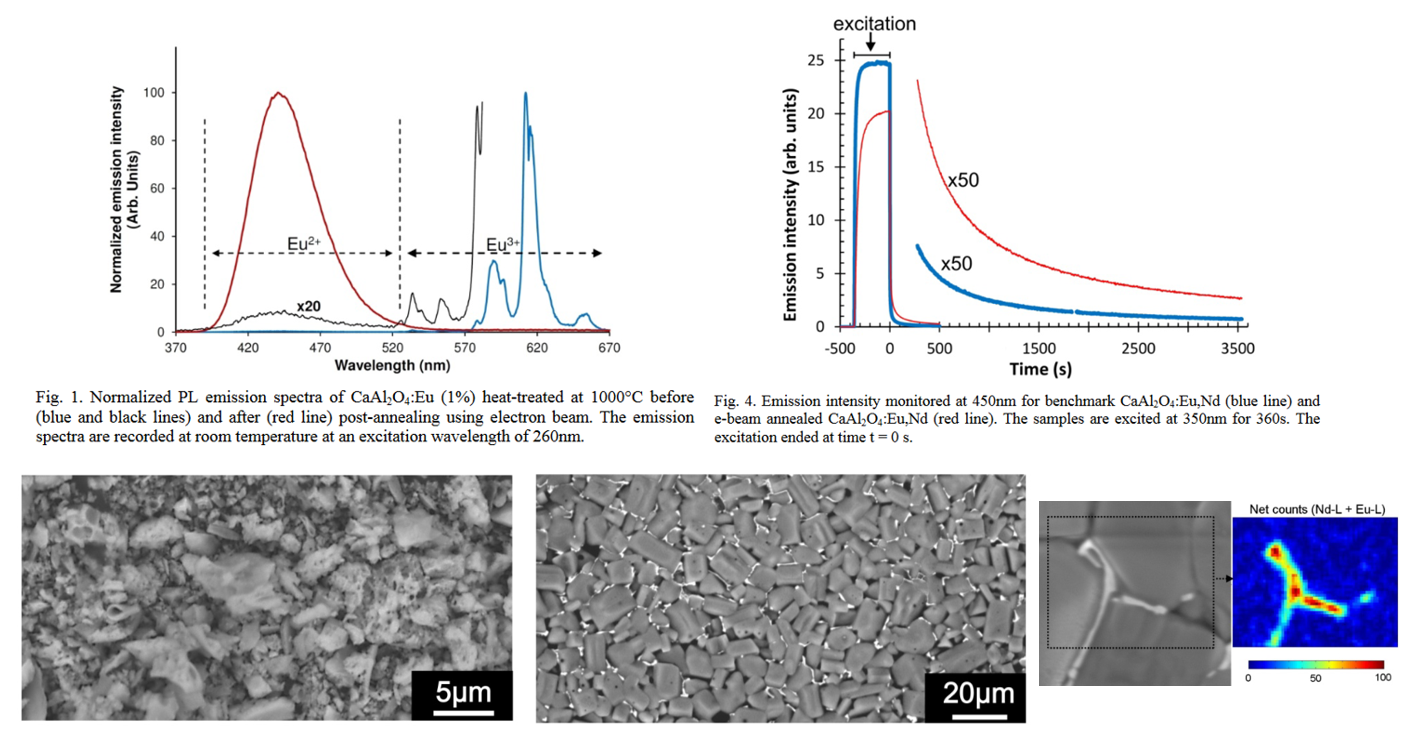
- Temporarily formed Eu3+: Nevertheless, we have recently shown that during the charging process (i.e. the excitation of the phosphor, leading to the trapping of charges in the lattice) Eu3+ ions are temporarily formed.
- Sol-gel的好处:Mixing of all constituent ions at the atomic level.
- Electron beam annealing的效果:irradiation of the phosphor by a focused electron beam. Efficient and fast reduction of the Eu ions, well-crystallized powders and bright afterglow were achieved.
-
- 光学特性:实验结果表明,作用5 s之后,在260 nm的激发下,也只有pure Eu2+的PL。这里得到的是a white body color,不像之前的OME在还原气氛下热处理得到的是灰色的样品。
- 晶相:It also leads to the formation of the monoclinic CaAl2O4 phase, which has been shown to be beneficial for the afterglow intensity. No impurity phases are detected in the x-ray diffraction pattern. The phase transition from the hexagonal phase (as present in the powders heat treated in air) to the monoclinic phase is complete. Furthermore, the narrow diffraction peaks, in combination with a much increased signal-to-noise ratio as compared to this for powder prior to the e-beam annealing, suggest a full crystallization of the powder after e-beam annealing.
- SEM:large grains with well-defined crystal facets are observed.
- 光学特性:实验结果表明,作用5 s之后,在260 nm的激发下,也只有pure Eu2+的PL。这里得到的是a white body color,不像之前的OME在还原气氛下热处理得到的是灰色的样品。
-
- E-beam annealing的three main effects:
-
- Well-crystallized: Rapidly heat to close to or slightly above the melting temperature. Also the fast cooling can be beneficial to quench a certain crystallographic situation.
- White body color and complete Eu3+ reduction: E-beam annealing的气氛是真空,提供了一个mildly reducing的环境。Without the extensive formation of defects, such as oxygen vacancies。
- The third important observation deals with the presence of the rare earth dopants in precipitates, as found at the grain boundaries.
-
- 结论:We found that electron-beam annealing is a viable option to reduce the europium ions in CaAl2O4:Eu,Nd powders. It leads to well-crystallized powders, having a long and bright afterglow. The differences between this method and standard thermal treatments in vacuum or in reducing atmosphere are a much faster heating, a higher temperature, short dwell time and fast cooling. Clearly, the white body colour and the full crystallization are beneficial for the afterglow intensity. It is clear that more research is required to elucidate not only the role of co-dopants in the trapping mechanisms in persistent phosphors, but also to pinpoint why electronbeam annealing is beneficial for this compound. Further improvements to the annealing method are situated in a better control of the heating profile (peak temperature, duration and cooling rate). The method was also briefly tested for a few other persistent phosphors. Preliminary results indicate that it performs well for the green-emitting SrAl2O4:Eu,Dy, but not for the orange-emitting Ca2Si5N8:Eu,Tm.
俄罗斯
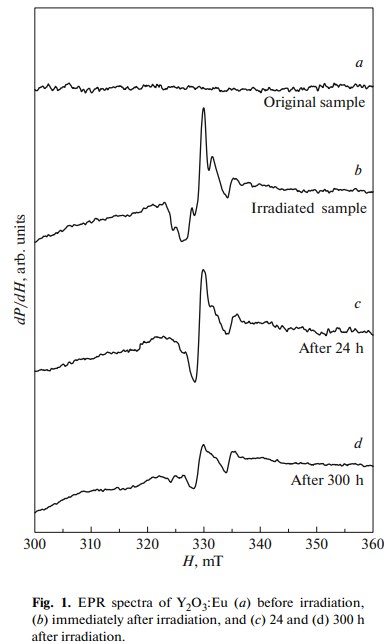
The Eu3+ ions can transfer to the charge transfer (CT) state [Eu3+ ← O2–] under the action of high-energy radiation (above 4 eV). In our case, the probability of the transition of the Eu3+ ion to the charge transfer state under the action of X-ray irradiation of the Y2O3:Eu3+ phosphor is rather high; the transition may be a result of the throwing of an electron from the valence band to the conduction band. That is, an electron can be transferred from the top of the valence band to europium centers through the conduction band, which corresponds to the transition of electrons from negatively charged O2– ions in the matrix to Eu3+ ions (Eu3+ –O2– → Eu2+ –O1–). Further, the reverse process of electron transfer from the rare-earth ion to the surrounding oxygen ions (Eu2+ –O1– → Eu3+ –O2–) occurs with time, that is, the ionization of europium Eu2+ → Eu3+. As described in, both radiationless and radiative relaxation is possible either immediately to the ground state of Eu3+ or first to the excited state of Eu3+ with a subsequent radiative transition 4f → 4f to the ground state of Eu3+.
Synthesis and study of europium doped BaI2 in glass ceramic form
荷兰
[EPR study of radiation-induced defects in the thermoluminescence dating medium zircon (ZrSiO4)-2002]- Tb4+的EPR信号,辐照后增强了,说明存在氧化过程,退火可以还原;
- Dy3+的EPR信号,辐照后减弱了,说明存在氧化过程,退火可以还原;
- Tb3+可以作为deep hole traps,Tb3+可以作为shallow hole traps。
瑞士
[Bleaching of Sm2+ during photoluminescence and cathodoluminescence-Optics Communications-2001]英国
奥地利
[Reversible Eu2+ ↔ Eu3+ transitions at Eu-Si interfaces-APL-1991]
澳大利亚
1.BaFCl:Sm3+
[Efficient X-ray Generation of Sm2+ in Nanocrystalline BaFCl/Sm3+: a Photoluminescent X-ray Storage Phosphor-IC-2007]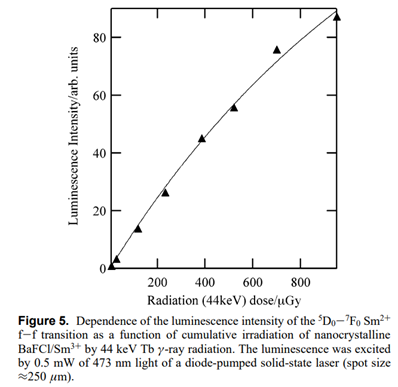
- For BaFCl:Sm3+, solid-state reaction and wet chemical reaction have been used to prepare this sample, respectively. For the latter method, the final products are nanocrystalline rather than microcrystalline in the first method. Nanocrystalline samples have more defects considering its small size and consequent surface-to-volume ratio, which can interpret the easiness reduction of Sm3+ to Sm2+ under X-ray irradiation when compared with the microcrystalline products.
- 辐照得到的Sm2+的稳定性:
-
- relatively stable and are not erased under ambient light conditions or under irradiation with low-powered lasers.
- exposure to >20 W/cm2 of 488 nm Ar+ laser light results in relatively rapid (reversible) erasure.
- After the erasure, the material retains its sensitivity to X-rays.
-
- 烧孔:We note here that the mechanism of Sm2+ photoionization in crystals of BaFCl/Sm2+ has been studied previously by hole-burning spectroscopy.
2.BaLiF3:Sm3+
[Efficient Generation of Stable Sm2+ in Nanocrystalline BaLiF3:Sm3+ by UV- and X-Irradiation-JPCC-2019]
- 虽然Eu2+-doped BaFBr(I)作为X-ray storage phosphor很成功,但是there is a continuing interest in exploring new luminescent materials that may potentially exceed the properties of Eu2+-doped BaFBr(I).
- BaLiF3是nonhygroscopic(不吸湿的),但是很多halide perovskite hosts are very hygroscopic。
- 制备方法: a facile mechanochemical process。
- Sm2+的发光:RT下有strong vibronic sidebands。
- Sm3+的发光强度没怎么变化,This may be because the absolute conversion to Sm2+ is still minimal, and hence the Sm3+ change is not measurable within the experimental error, or the Sm2+ is exclusively generated from Sm3+-defect pairs that are initially nonluminescent.
- BaLiF3:Sm3+ also has the capability of storing UV radiation (185 nm) in addition to the X-ray storage capacity. The UV storage effect is most likely based on photoinduced electron transfer from oxide ion impurities to the Sm3+ centers.
- X射线辐照得到的Sm2+发光的寿命比晶体生长得到的Sm2+的寿命更短,因为ball milling合成过程中产生了更多的缺陷that quench the excited state。
- Bleaching: the sample was first exposed to an X-ray dose of 6 Gy and was then bleached by applying ∼8 W cm−2 of 462 nm laser light. 注意之前也是用462 nm激发测Sm2+发光。
3. BaFCl:Sm3+
[Highly efficient valence state switching of samarium in BaFCl:Sm nanocrystals in the deep UV for multilevel optical data storage-OME-2016]
- 样品是co-precipitation方法合成的。
- MFX (M = Ba, Sr, Ca; X = Cl, Br, I)体系,P4/nmm matlockite structure (PbFCl)结构很多人研究,因为发现了Sm2+掺杂的RT光学烧孔。These systems therefore have the potential to be used in practical frequency or time domain optical data storage as they allow for the writing of multiple bits into the same spatial location.
- Oxygen impurities:前人的研究成果strongly imply that nanocrystalline BaFCl, as prepared by co-precipitation followed by a drying and grinding step in air, may contain significant concentrations of oxygen and hydroxide impurities. The former can be incorporated as O2- or (O2)2-. Oxygen impurities allow for highly efficient Sm3+→Sm2+ in the deep UV region around 200 nm.
- The formation spectrum of F(Cl-) (注:F指的是F-心) for a single crystal of BaFCl (with oxygen impurities) is also shown for comparison and appears to be very similar to the formation spectrum of Sm2+. The wavelength dependence clearly indicates that the reduction of Sm3+ to Sm2+ is based on direct excitation of oxygen impurities.
特别注意:作者认为黑色的线和蓝色的线有直接关系,虽然图中看起来黑色的线和红色的线很像。

- The simplest possible photochemical reaction $$\mathrm{O}^{2-}+\mathrm{Sm}^{3+}+\mathrm{h} v \rightarrow \mathrm{O}^{-}+\mathrm{Sm}^{2+}$$即使在10 K下,表现出的Sm2+ formation spectrum都一样,说明是temperature-independent。但是别人观察到的formation of F(Cl-) centres是temperature-dependent,说明这不是同一个过程,虽然谱图看起来很像。因此作者认为oxide impurities的谱(红线)与Formation spectrum of Sm2+相对应,看起来有点扯。注意,在作者另一篇文字[Photoreduction of Sm3+ in Nanocrystalline BaFCl-JOCA-2015]中写道BaFCl:Sm3+ exhibits a broad transition at around 230 nm.
- X射线辐照、UV辐照、ball milling样品(直接得到Sm2+):
-
- X射线辐照,使得Sm3+的发光有减弱,但是UV辐照的没有减弱。这说明UV-generated Sm2+ luminescence stems from Sm3+-oxide impurity defects (这种构型quenching of the Sm3+ luminescence)。
- 测量Sm2+的激发谱,谱形都差不多,说明conclude that the local environment for the UV and X-ray generated Sm2+ ions is essentially the same as for the sample where Sm2+ is directly built into the lattice by ball milling. Thus the oxide impurity that is responsible for the reduction of Sm3+ upon UV exposure cannot be a next nearest neighbour on the F- or Cl- sublattice but the separation must be at least a few interionic distances.
-
- It is very difficult to bleach the last 1-2% of Sm2+ ions. The residual Sm2+ may be due to the temperature induced motion of the defect pairs which may lead to larger separations which are inaccessible for the electron transfer.
- 作者说了The Sm2+ can be bleached back to the 3+ valence state by excitation into the 4f6 →4f55d1 transitions,但是并没有波长依赖的实验。
- 还原机理:双光子过程,对于bleaching过程,作者通过拟合也认为是双光子过程。
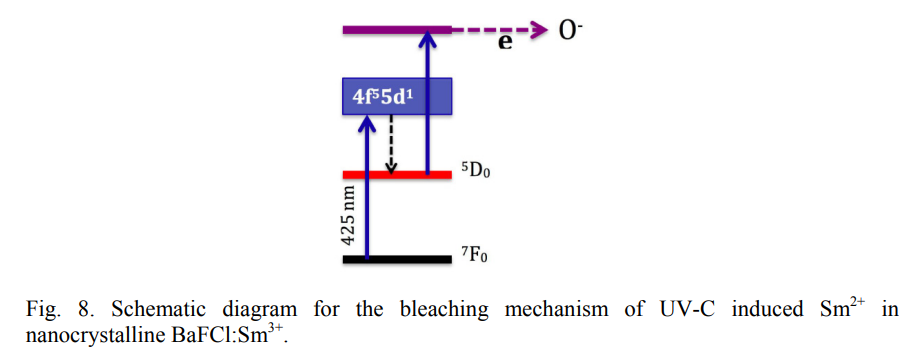
3-拓展:
[Optical spectra of oxygen defects in BaFCl and BaFBr crystals-JPCS-1995]
BaFBr:Eu2+晶体(禁带宽度8.3 eV) is used as X-ray image plates. 通常其含有large amount of oxygen (100 ppm and more),可能对发光性能有很大的影响。
摘要:We have found two kinds of oxygen-vacancy centers in barium fluorohalide crystals and denoted them as centers of types I and II. On the basis of the growth conditions, absorption spectra and other data one may conclude that centers of the first type consist of oxygen substituting at F- sites and neighboring Cl- or Br- vacancies. Oxygen-vacancy centers of the second type seem to be completely on either the Cl or the Br sublattice.
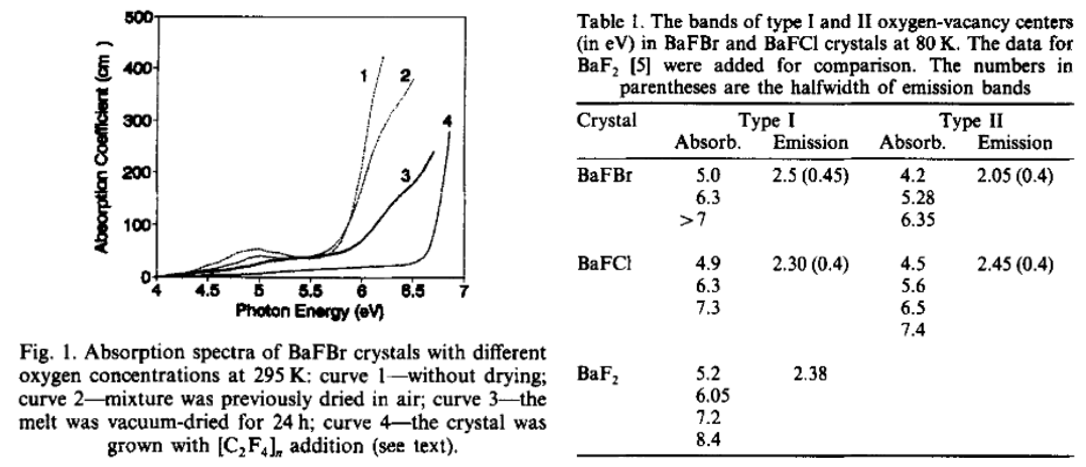
- 晶体中O的存在会enhance F center generation under X-irradaition。
- The optical transitions in oxygen-vacancy centres were assigned to electron transfer from the oxygen to the anion vacancy and vice versa. [Time-resolved luminescence of oxygen-vacancy centres in alkaline-earth fluoride and barium fluorohalide crystals]
- 这些oxygen-vacancy centres easily aggreate and photodissociate,吸收峰和oxygen-vacancy有关,氧含量越少的样品,这个吸收峰越不明显。
- oxygen-vacancy centres不仅表现出吸收,也可能有发光;更高能量的吸收峰可能是对应于激子的吸收峰。
- Photodissociation:oxygen-vacancy centers in alkali halide crystals above 200 K follows the reaction $$\mathrm{O}^{- -} \nu_{\mathrm{a}}^{+}+\mathrm{h} \nu \rightarrow \mathrm{O}^{-}+\mathrm{F}$$上述反应不是很有效when a crystal is irradiated into the low absorption band。别人的报道和本文作者的报道都证实了the photoionization of O- - ions and subsequent capture of electrons by Br- vacancies leads to the creation of O- and F(Br-) center.
4.BaFCl:Sm3+
[Mechanochemical synthesis of nanocrystalline BaFCl:Sm3+ storage phosphor by ball milling-Chemical Physics Letters-2013]
- 含水的BaCl2原料facilitates faster formation of BaFCl nanocrystal。
- 很少的一部分Sm2+在球磨过程中就产生了。
- CL测试说明氧化和还原过程是一个equilibrium过程。
- 球磨得到的样品相比共沉淀方法得到的样品,其X射线辐照的还原效率低一个数量级。
3.BaFCl:Tm3+
[Controlled Generation of Tm2+ Ions in Nanocrystalline BaFCl:Tm3+ by X-ray Irradiation-JPCA-2017]
6.BaFCl:Sm3+
[Effects of Postannealing on the Photoluminescence Properties of Coprecipitated Nanocrystalline BaFCl:Sm3+-JPCA-2013]
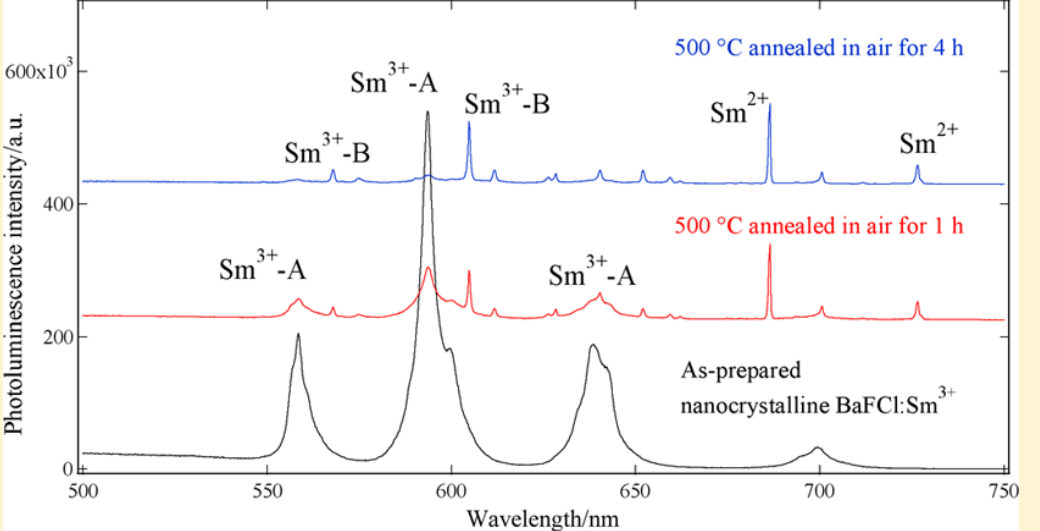 Nanocrystalline BaFCl:Sm3+, as prepared by coprecipitation from aqueous solutions, is an efficient photoluminescent X-ray storage phosphor. In the present study, we report effects on its photoluminescence properties resulting from postannealing treatment in air in the temperature range between 100 to 900 °C. Interestingly, upon annealing at temperatures from 200 to 600 °C in air, a small fraction of the Sm3+ ions in nanocrystalline BaFCl can be reduced to Sm2+ ions. In addition to the creation of Sm2+ ions, two different sites of Sm3+ ions, denoted as sites A and B, are observed when the nanocrystalline BaFCl:Sm3+ is annealed between 500 to 900 °C. The temperature dependence of photoluminescence properties of the two different sites in the 500 °C annealed sample reveals that the Sm3+ ions at site A are possibly located at or near the crystallite surface, whereas site B is situated in a very ordered environment. To the best of our knowledge, this is the first report on the reduction of Sm3+ ions doped in alkaline-earth fluorohalides to Sm2+ ions by annealing in air.
Nanocrystalline BaFCl:Sm3+, as prepared by coprecipitation from aqueous solutions, is an efficient photoluminescent X-ray storage phosphor. In the present study, we report effects on its photoluminescence properties resulting from postannealing treatment in air in the temperature range between 100 to 900 °C. Interestingly, upon annealing at temperatures from 200 to 600 °C in air, a small fraction of the Sm3+ ions in nanocrystalline BaFCl can be reduced to Sm2+ ions. In addition to the creation of Sm2+ ions, two different sites of Sm3+ ions, denoted as sites A and B, are observed when the nanocrystalline BaFCl:Sm3+ is annealed between 500 to 900 °C. The temperature dependence of photoluminescence properties of the two different sites in the 500 °C annealed sample reveals that the Sm3+ ions at site A are possibly located at or near the crystallite surface, whereas site B is situated in a very ordered environment. To the best of our knowledge, this is the first report on the reduction of Sm3+ ions doped in alkaline-earth fluorohalides to Sm2+ ions by annealing in air.
7.BaFCl:Sm3+
[Photoluminescence and Cathodoluminescence Properties of Nanocrystalline BaFCl:Sm3+ X-ray Storage Phosphor]
- CL和PL对比:Photoluminescence and cathodoluminescence have often been utilized to distinguish between Sm3+ and Sm2+ ions in a range of different hosts. Mikhail et al. have compared the cathodoluminescence and photoluminescence of Sm2+ and Sm3+ in oxide environments26 and proposed that the cathodoluminescence detects predominantly Sm3+ ions due to ionization of Sm2+ ions by the electron beam, whereas photoluminescence is sensitive for detecting both oxidation states of samarium ions.
- 作者观察到的CL和别人不一样:During the cathodoluminescence measurements, both the reduction of Sm3+ ions and the oxidation of Sm2+ ions can occur upon electron bombardment, and the spectra obtained reflect the equilibrium between the two processes and therefore the two oxidation states.
- 摘要:
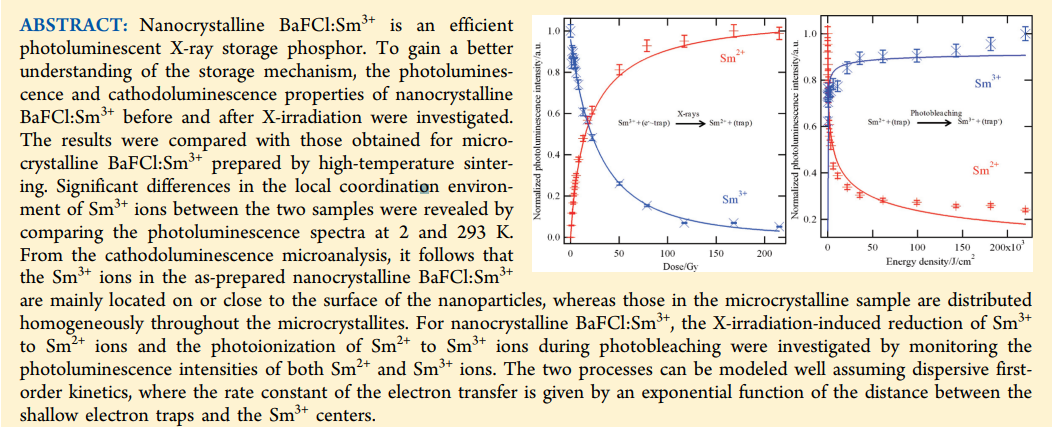
8.[Photoreduction of Sm3+ in Nanocrystalline BaFCl-JOCA-2015]
- 低辐照功率(430/480 nm 激光):In previous studies, rather high laser power densities were employed; for example, in ref 8, where 130 fs (λ = 800 nm) laser pulses were used, a power density of 3.5 × 1015 W/cm2 is reported, whereas in ref 10 a power density on the order of 1014 W/cm2 is stated. In the present study we have used significantly lower laser power densities on the order of GW/cm2 , that is, up to a million times lower, as the Sm3+ → Sm2+ conversion efficiency in nanocrystalline BaFCl appears to be high for blue light as is documented below.
- 电荷迁移态:The faster rate is possibly due to twophoton excitation into the Cl− → Sm3+ charge-transfer (CT) transition. BaFCl:Sm3+ exhibits a broad transition at around 230 nm.
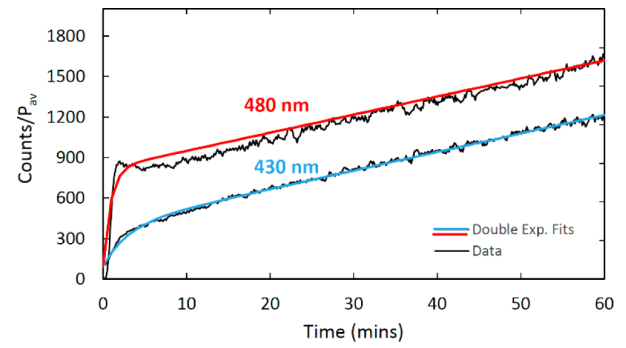
9. Ba0.5Sr0.5FCl0.5Br0.5:Sm3+
[Room Temperature Hole-Burning of X-ray Induced Sm2+ in Nanocrystalline Ba0.5Sr0.5FCl0.5Br0.5:Sm3+ Prepared by Mechanochemistry-JPCA-2014]
光学烧孔的介绍:Spectral hole-burning is a powerful technique in laser spectroscopy, and it is based on frequency selective bleaching of a subset of optical centers within an inhomogeneously broadened transition by a narrow band laser, resulting in a spectral hole (dip) in the absorption spectrum at the selected frequency.
9.重点阅读
[Thermoluminescence and radiophotoluminescence from Eu-and Sm-doped CaSO4-PSS-1984]
重点
10. [Ultraviolet-inducedcharge transfer in CaSO4:Eu-1988-IOP]
新西兰-NaMgF3:Yb/Sm/Eu
在很多材料中,Sm3+作为electron trap,可以捕获导带中的电子,形成亚稳态的Sm2+。 Eu2+的d-f跃迁发光通过导带的热猝灭已经well established。但是对于Sm2+来说,photothermal ionization的研究很少。这篇文章中,我们报道了变温PL和RPL。我们证实了Sm2+在高温下的热猝灭是通过photothermal ionization 电子到导带。我们也证实了,Sm2+的RPL发光可以被reversed simultaneous optical and thermal stimulation。 这种photothermal ionization的方法可以用于一系列宽禁带材料,来确定Ln2+的trap深度。

xxxx
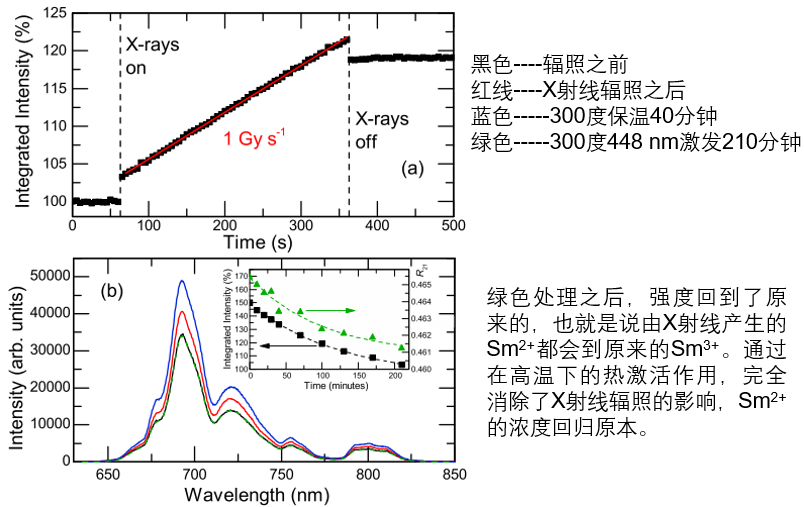
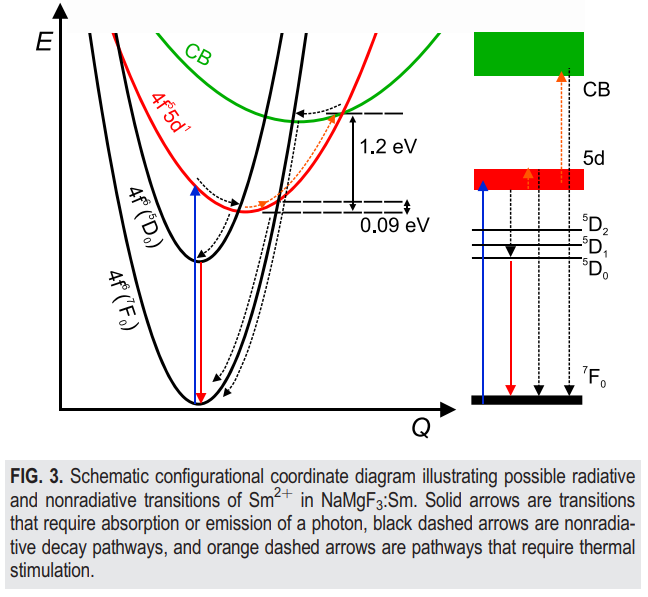
xxxx
4. [Modelling the radioluminescence of Sm2+ and Sm3+ in the dosimeter material NaMgF3: Sm—2019]
6. [Optically reversible Tm3+ → Tm2+ radiophotoluminescence in NaMgF3:Tm]
印度/巴西/加拿大/以色列
印度
1. Sr2SiO4:Eu2+
[The light induced valence change of europium in Sr2SiO4 ∶ Eu involving transient crystal structure-JMC-2004]
2. 总结Eu辐照变价的基质
[Radiation-induced valence changes in Eu-doped phosphors-Journal of Physics: Condensed Matter-1997]
4. NaLi2PO4:Eu3+
[Radiation Induced Abnormal Reduction of Eu3+ and Luminescence Properties of NaLi2PO4:Eu-垃圾期刊-2016]
巴西
1.CaAl2O4:Eu2+
[Effects of X-ray irradiation on the Eu3+→ Eu2+ conversion in CaAl2O4 phosphors -OM-2018]
2.[]
3.[]
4.[]
5.[]
加拿大
1. Ga2O3: Eu3+
[Dual Europium Luminescence Centers in Colloidal Ga2O3 Nanocrystals: Controlled in Situ Reduction of Eu(III) and Stabilization of Eu(II)-CM-2015]
DAP emission (Donor-acceptor-pair emission)
 The exposure of these samples to X-ray radiation leads to the reduction of Eu3+ to Eu2+, demonstrating an alternative way of manipulating the oxidation state and suggesting the potential application of this material as an X-ray storage phosphor.
The exposure of these samples to X-ray radiation leads to the reduction of Eu3+ to Eu2+, demonstrating an alternative way of manipulating the oxidation state and suggesting the potential application of this material as an X-ray storage phosphor.
The Eu2+/Eu3+ concentration ratio decreases with increasing starting Eu3+ precursor concentration.
以色列
1. Eu3+ in aqueous solution
Irradiation in the CT band of Eu3+ in aqueous solution, in the presence of scavengers for H atoms, gives rise to formation of Eu2+ and evolution of molecular hydrogen.
[The Photochemistry of Solutions of Eu(III) and Eu(II)-Israel Journal of Chemistry-1972]